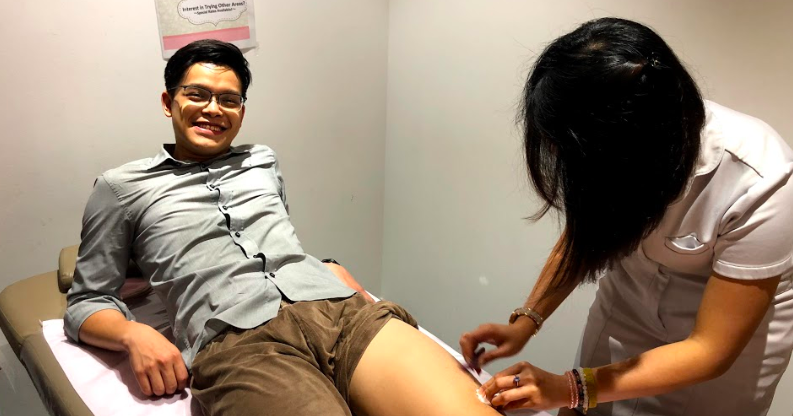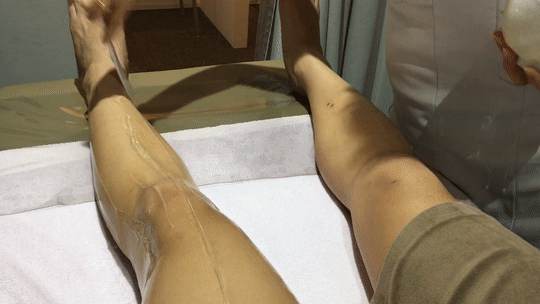So my colleagues thought it would be a great idea to have me remove my leg hair. And document the process. Because pageviews and LOL.
Game on.
Heck, I’ll see you and raise you.
How about removing hair on only one leg? Let’s make my virgin attempt worth it.
The Methodology
First things first, here’s how we are going to get there.
One word, six syllables. Photothermolysis. In simple terms, this means that light (photo) is used to generate heat (thermo) which damages (lysis) hair follicles so that they do not regrow.
Photothermolysis is the science behind Intense Pulsed Light (IPL) hair removal, which has been around for a while, as well as Super Hair Removal (SHR), which is newer and less common.
You might ask: what’s the difference between IPL and SHR? Read on for flashy GIF or skip wall of text for TL;DR.
IPL vs SHR: What you need to know
IPL: Shots
SHR: Sweeps
IPL is done in shots, and some hair removal studios actually charge per shot. But glasses are not involved. Instead, what this means is that the IPL machine is positioned in one place before the laser is “shot” in individual pulses with high heat. This is why IPL is also called the “stamp” method.
SHR on the other hand, is done in continuous sweeps, which helps to reduce the amount of heat that builds up in any particular area.
 Continuous motions prevent buildup of excess heat
Continuous motions prevent buildup of excess heat
IPL: Multiple wavelengths
SHR: Tailored wavelengths
IPL uses as many as hundreds of wavelengths in each pulse of light, many of which end up being absorbed by the skin, being converted to heat (and an unpleasant, warm sensation) which does not help to reduce hair growth.
SHR, on the other hand, uses only the wavelengths which are tailored for the best results.
IPL: Tends to be cheaper
SHR: Tends to be more expensive
It’s widely known that SHR tends to be more expensive - after all, it’s newer, and more effective, for the same number of treatments.
IPL: Works best on lighter skin tones and darker hair
SHR: Works on a range of skin tones, from light to medium-dark
IPL is not advised for people who have darker skin because melanin in the skin can end up absorbing too much of the light pulses, causing damage, discomfort, and sometimes, even third-degree burns.
Because SHR, on the other hand, targets specific wavelengths, it can be effective even for those with medium-dark skin.
However, both IPL and SHR are not advised for those whose skin is especially sensitive due to medication, hormonal fluctuations (eg. those caused by pregnancy or menstruation), or sun-tanning.
TL:DR: IPL is cheaper, but can be more damaging (especially to darker skin tones) and not as “painless” as SHR.
The Place
Datsumo Labo, a Japanese hair removal company. I went to the one located at Orchid Hotel, Tanjong Pagar.
The very friendly folks told me that 10% of their customers are male; while I’m still in the minority, I’m clearly not an unicorn.
 Getting schooled about hair removal technology in lovely pink slippers
Getting schooled about hair removal technology in lovely pink slippers
And.... I’m in.

If you, like me, were expecting primal screams from some excruciating pain, then you’d be disappointed.
Things didn’t get hairy. At all.
Allow me to explain
Because my skin tone is medium-light and my leg hairs were not very thick, I didn’t feel much heat throughout the process.
I do, however, have a darker patch of skin on my kneecap and thus felt a little bit of a warm, stinging sensation when that area was being treated - but I would describe it as being more unusual than painful.
To make it totally relatable for Singaporeans, it’s like going under a $4 ERP gantry -- you feel it for a second, and the feeling subsides soon after.
Most of what I felt was a cold sensation from the special gel which was applied before the treatment.
 So this is what it feels like to be a bread?
So this is what it feels like to be a bread?
As I later found out, Datsumo Labo’s proprietary Princess GelTM has plant-based microbeads. When the microbeads are exposed to light from the machine, they break down into a substance which is absorbed by the skin, with whitening and moisturising effects.
Moisturised skin allows the machine to calibrate the light waves to match skin color more accurately, for more effective hair removal.
Well, now you know.
 Take a close look because this is literally the secret sauce.
Take a close look because this is literally the secret sauce.
The Results
The leg after 20 mundane minutes.
 Hairless leg (left) vs not-very-hairy leg (right)
Hairless leg (left) vs not-very-hairy leg (right)
Ok, granted - my legs really aren’t that hairy to begin with, so the contrast wasn’t exactly obvious.
But after the treatment was done, my hairless leg looked and felt as smooth as my hairless bottom.
Good news, I guess? The only thing burning was this question that I had while the deforestation was taking place: “When will the hair grow back?”
I wasn’t expecting anything permanent like a tattoo. I still love my berms very much.
But will my leg stay hairless 5eva?
The first thing to know is that the effects probably won’t be instant. My left leg (which underwent the SHR treatment) would really look quite similar to my right leg if I shaved it. Which is why it was a bad idea for me to only get one leg treated.
Results vary from person to person, but many customers are satisfied with the results after around 6 to 12 sessions, depending on how thick the hair growth is and skin type.
Much to my dismay, I was told that some customers do see that hair growth slows down noticeably after just one session.
Which also meant that I could be stuck with a hairless left leg for quite a while.
 Hearing the bad news...
Hearing the bad news...
Probably something that would make you happy if you were seriously looking for hair removal treatment, but not the best piece of news for a berms-loving guy like me.
Oh well.
-
If you’re considering getting SHR treatment done at Datsumo Labo, get 31% off packages as part of their Halloween promotion, which will run till 31 Oct.
From 19 Oct to 28 Oct, you can sign up for unlimited sessions on all Mini Areas (such as underarms, nape of neck, etc) for $388. Find out more here.
This sponsored article by Datsumo Labo left the author hairless on one leg, and feeling a little self-conscious when wearing shorts.
If you like what you read, follow us on Facebook, Instagram, Twitter and Telegram to get the latest updates.
